btf-D18
07.07.11
BACK TO THE FUTURE:
Hypertext the Way It Used To Be
Theodor Holm Nelson and Robert Adamson Smith
Project Xanadu
ABSTRACT. Others imitate paper (Word,
Acrobat) and the constant 3D world we live in ("Virtual Reality"). Our
system instead tries to create documents better than paper in a space better
than reality.
Intellectual property notice: The following
are trademarks of Project Xanadu, registered or claimed: Xanadu, ZigZag,
XanaduSpace.
The purpose of hypertext was always to make up for the
deficiencies of paper. Paper cannot easily show connections, has very
limited space, and forces an inflexible rectangular arrangement.
Hypertext, the generalization of writing, potentially offers many forms of
interconnection and presentation beyond what paper allows. But so far
the mechanisms, not the users, have been put in control.
Here are mechanisms that get in the way:
1. The simulation of paper. Much of
the field has imitated paper: in word processing (Microsoft Word and
Adobe Acrobat) and the World Wide Web, whose rectangular page layouts become a
focal issue. It should be noted that these systems imitate paper
under glass, since you can't annotate it.
The imitation of paper has been enforced by the motto
WYSIWYG, "What You See Is What You Get"-- meaning what you get when
you print the document out. This simple propagandistic locution
legitimizes paper simulation, and printout, as the proper destined objectives
of computer documents.
This ignores the more important possibility: how
improve on paper? WYSIWYG seems to us absurd: by fetishizing
print layout (typeset vertical strips) as the only view of a document, we
penalize the user. Any number of views-- and structures-- should be
possible.
2. The imitation of physical space.
Extending the imitation of paper, the usual approach to 3D has been "virtual
reality"-- the literal imitation of 3D space, where we go beyond imitating the
paper to imitating the desk, the room, etc. This extends the same
limitations of paper simulation to 3D: everything must be literal, everything
must stay the same size in a constant metric. Again, we believe this is
very limiting, and has been the reason for the fading of the Virtual Reality
movement. The real issue is: how improve on conventional
space?
3. Crude links. At least since the
Hypertext Editing System at Brown University in 1968 (10), hypertext links
have generally--
- been one-way
- not
allowed overlapping of either source or target endsets ("anchors")
- not had types
This crude
structure has been a source of regret for which some of us have apologized in
print (2). Crude links drastically reduce the types of document,
structure and connection that can be represented.
4. Embedded, inextricable
hierarchy. The web formats, including more
recently XML and Cascading Style Sheets, are all based on internal
hierarchical representation of structure and markup. This further limits
the forms of structure which can be represented.
3. Simplistic mapping to files. The
standard paradigm of files, unquestioned almost everywhere, drastically
affects how everything works. One document is assumed to be one file-- a
strange requirement, but it reinforces the one-way linkage restriction
currently in place on the World Wide Web. (Since the HTML file contains
the links, they can only point outward.)
In this conventional file model, "metadata" can be only on
files as a whole; there is no way for metadata to flag, mark or protect
particular contents of files.
We believe people accept these limitations because they do
not perceive them as limitations, or imagine alternatives.
People accept th
AN EXPERIMENTAL SYSTEM FOR
GENERALIZED DOCUMENTS
We are not just building a different kind of
hypertext, but seeking the most general form of document. The issue is
how to represent all possible documents. This means throwing
away: simplistic file mapping, paper simulation, 1-way links, hierarchical
markup, WYSIWYG and the simulation of fixed 3D space.
Our document structure is very different from paper (although
rectangularity is allowed as an option). A document may be divided into
arbitrary units; the default visualization is a vertical strip, but very
different structures and presentations are also possible. A document may
consist of any number of such pieces, which we call "vunits," or viewable
units.
Text may in principle be organized and shown in such vunits
as
- rectangular pages
-
text stramers and "crawls"
- overlays
- flying paragraphs
- fountains
of text
- rippling surfaces
- animated and changing texts
and
other structures to be definable later. (We can even call them all
"pages," provided the possible variety is understood.)
These are intended not just as novelties, but as full-status
content packages: all contents are
- linkable
-
transclusible (showing their origins)
They
may all be connected side-by-side, like columns in a book, table or
spreadsheet..
We allow any number of
- links
- structural
relations
- views
-
interactive methods
all selectable by the
user.
This is transliterary structure, discussed
below.
RETURNING TO THE ORIGINAL
VIEW
The earliest published design for computer hypertext
was a 1965 ACM article (peer-reviewed) which canonically defined our work
(0). One of the authors (Nelson) presented a sweeping view
of hypertext as visibly cross-connected by two-way links and transclusions*
(illustration from that article reprinted here as Fig. 1).
* I define "transclusion" as "the same content
knowably
in more than one place";
therefore, any presentation which indicates
the identity or origins of media content.
There are other meanings of
"transclusion"
which are special cases. For instance,
"transdelivery" means bringing content
from elsewhere,
"transquotation" means explicit quotation
which remains connnected to
its origins.
Vannevar Bush's famous "trails," described
in 1945 (1), were
transclusions, not links.
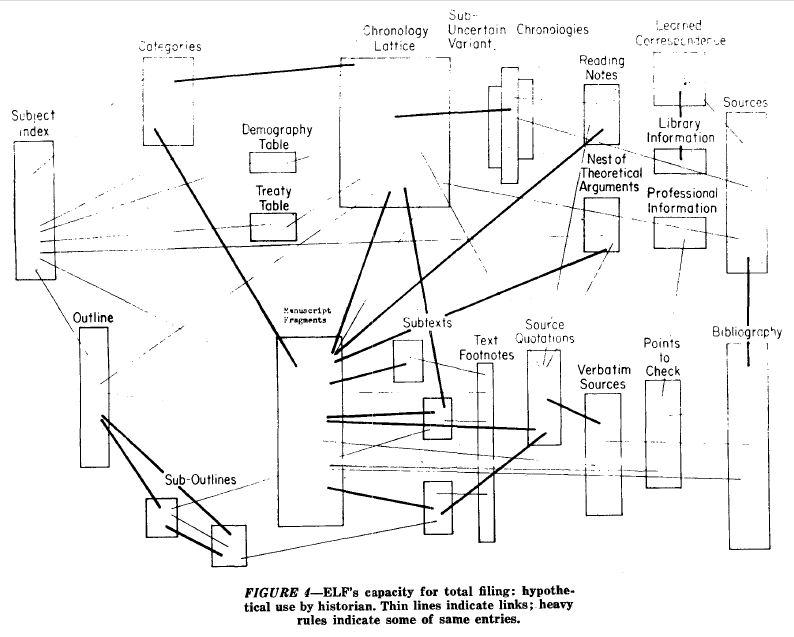
Fig. 1 Panoramic view of postulated hypertext, 1965
(fig.4 from (0))
Subsequent hypertext has been very different, based on
one-way non-overlapping links, as established in 1968 (10) but clearly
foreshadowed by Engelbart (11, 12). We return now to our previous 1965
model, implementing a generalized document structure and showing it in an
unusual space that offers great flexibility. In addition, we have a
presentational mechanism (the reading plane or line of fire) that makes it
easy to follow connections in a complex hypertext structure.
Note that the connections in this picture are two-way.
(Light lines represent one or more links, heavy lines represent one or more
transclusions-- described then as "some of same entries".)
We believe that this link-and-transclusion view is still
fundamental. It is exactly what we have implemented today in the
"XanaduSpace" software, as shown by a screenshot (Fig. 2). Dark bands in
the screenshots are links, red bands are transclusions.
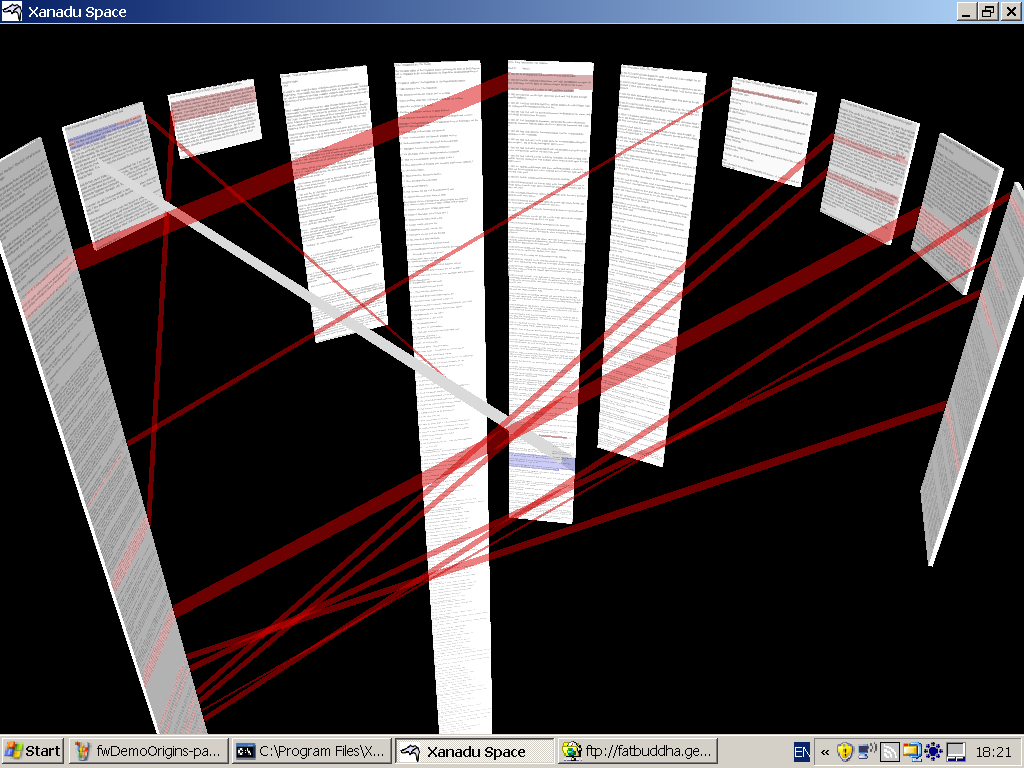
Fig. 2. Panoramic view of hypertext in
XanaduSpace.
These two types of connection (links and transclusions) may
overlap in any quantity-- for instance, connecting a given paragraph to
numerous other documents.
ANY NUMBER OF VIEWS
Instead of WYSIWYG, we may view a page or vunit in a
variety of ways-- for example, rolled into loops (Fig.3). Many more
views may be added with relative ease.
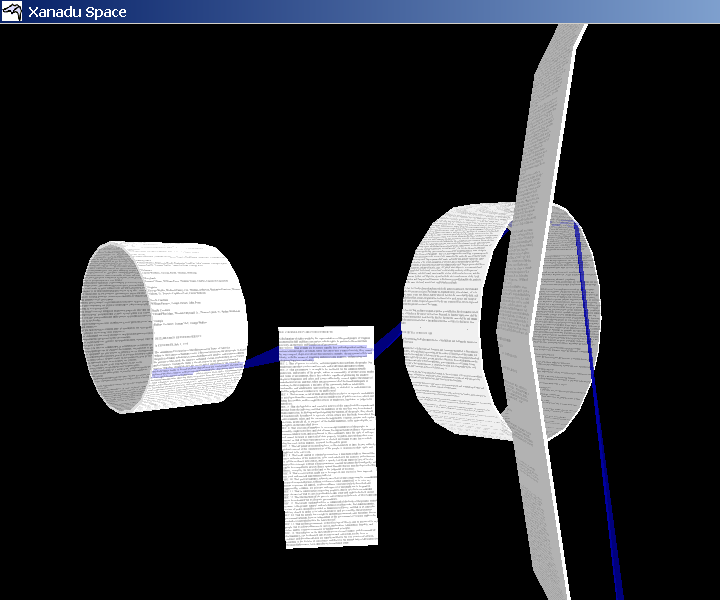
Fig. 3. Documents shown in loops
(XanaduSpace).
This extensibility of views can have numerous advantages for
document use and understanding.
A SYSTEM
OF SIDE-BY-SIDE VIEWING
A key problem of hypertext is colloquially called
"lost in hyperspace." To be lost in hyperspace usually means that you
don't know where you came from or where you can go in a world of invisible
links. However, even when the connections are made visible, they can be
hard to follow-- especially as they grow in number.
We have found a new viewing mechanism that seems to answer
this problem.
We call our solution the reading plane, or line of
fire. (Fig. 4)
The reading plane shows a current page or vunit in 3-space,
at center screen. This allows close-up reading in a larger context--
showing both content and connections to vunits elsewhere. The user may select a current link or transclusion in the current
page, causing the vunit at the other end of the connection to swing into
position beside it. We call this the companion page, shown here with
smaller type than the current page (figs. 4, 5).
The user may switch attention to the companion page, making
it the current page.
This appears to work very well. The user can clearly
read the current page and follow connections in it. The user can also
see what page is swinging into position and what pages are not
current.
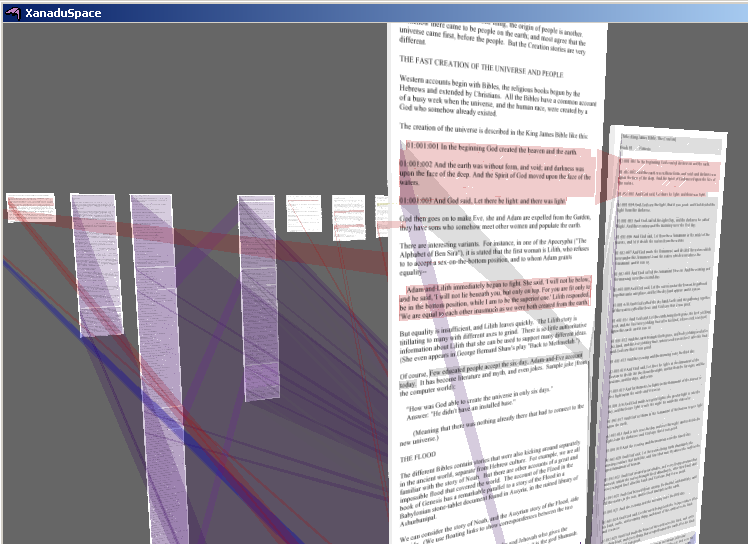
Fig 4: Two pages in line of fire, other pages
of hypertext visible. (XanaduSpace.)
The line of fire is also particularly good for seeing
tranclusive origins (fig. 5).
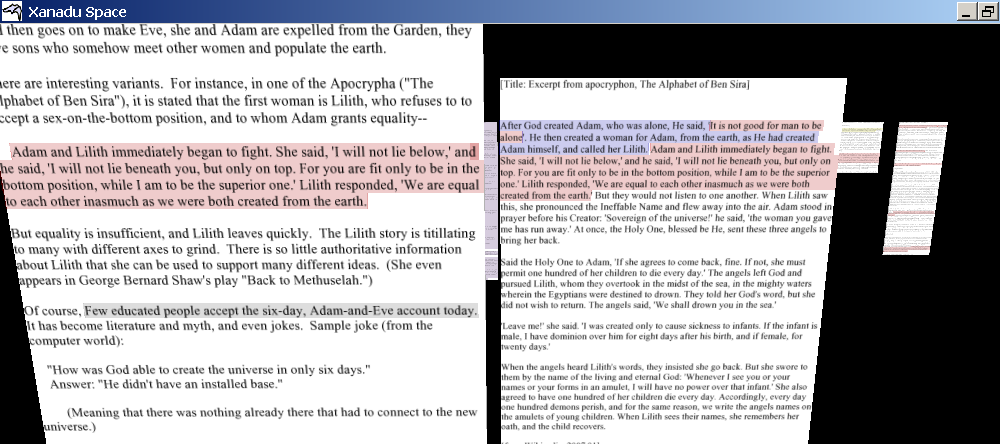
Fig. 5. Line of fire, showing transclusion from
companion document to current document (XanaduSpace).
The line of fire thus shows the current page and at least one
connected page close up and readable, yet at the same time a whole scene of
many pages can remain visible to show all the connections among them at
once.
TRANSLITERARY
STRUCTURE, AN OPEN STANDARD
The documents of XanaduSpace follow the open
document standard of Transliterature, or transliterary format, as defined at
transliterature.org.
Transliterary structure is meant to be the fullest
generalization of documents. This means being able to represent all
possible document structures, and to deal with the vicissitudes of change,
versioning and copyright.
Transliterary structure is the latest version of the Xanadu
project. "Documents" are packages of content constructed by authors from
new and old text, audio and video, in any arrangement and pieces and desired
appearance. And "literature" means collections of documents, with all
their possible connections.
The Xanadu project has sought to solve all at once the issues
of--
- profuse links of many
types
- recognizable re-use of
content from elsewhere
- version
management
- distributed
update
- copyright (esp. through
individual purchase of portions through a micropayment system)
(7)
Instead of one package of primary content and embedded links
in a single file (the HTML model), we separate--
- document model
- content acquisition
- simple structure (parallel strips of
content)
- overlaid structure
(rearrangement, typography)
-
external structure (links)
-
history
We believe this approach can solve these many problems, and
others; but it requires totally different forms of representation and methods
that may seem counterintuitive and overly complex to those used to the present
computer world. However, the conventional methods require wide-ranging
external methods to achieve what we try to achieve directly through these
document structures and methods.
STABILIZED ADDRESSES
Imagine that everything you type is given a
permanent, immutable address. Then to refer to a given sentence, or
paragraph, you would refer to its permanent address span (start,
length). This would have many benefits.
This is not the way things are ordinarily done, but in this
system we simulate such permanent addresses in order to get these
benefits.
LOGIC OF THE
SYSTEM.
0. A transliterary document is delivered as an
EDL, or Edit Decision List, which is empty of content--
- a list of content to be put together (currently
text, later audio and video)
- a
list of floating links to be overlaid on that content
A document may contain one or more visible units (pages,
flying paragraphs, etc.) to be fulfilled with content.
1. A client program (such as XanaduSpace) sends for the
content of the document from the respective addresses of the different
portions. They may be local, remote, or both.
Addresses of content don't change, since content portions are
based on stabilized addresses. The obvious issues of availability and
stabilization we see as pragmatic (5,8). (This has been widely
misunderstood in comments on our work; people have thought we would reach
across the net for every instance, and that broken network connections or
changed source documents break the model. This misunderstands our
broader intent. Naturally, the material can be cached; but the logic of
the system maintains its original identity and address.)
2. Once these pages have been fulfilled with their
content, they may be overlaid with flinks (floating links), which may include
relations, structure and typographical markup. Links are neither
embedded nor hierarchically represented.
3. Transclusions are not present in the data structure;
the client program discovers transclusions by finding identities in the
addresses.
4. The default structure (vertical strips or pages) may
be overridden by structural flinks.
Additional aspects of XanaduSpace are discussed in a current
paper (8).
ESCAPING THE FILE
PRISON: RULE OF COMPOSITION
To escape from the limitations of files as we now
know them, transliterary structure has been designed to obey a particular rule
of combination: Division into files need not affect the
structure. Transliterary document structures may be broken into
files many different ways and still behave the same way.*
* This also applies to our hyperthogonal
database structure,
ZigZag, which may likewise be
broken into files variously.
ESCAPING FROM VIRTUAL REALITY: (N)D FOLDING
SPACE
By "folding space" we mean a pseudospace, presented
to a user, whose proportions can be changed in more than three
dimensions.
For example, a 3D model of a house may be squashed flat into
a 2D picture, or stretched out of proportion. It can also, in principle,
be extended into a fourth dimension showing its physical changes and value
over time, and other dimensions showing parametric variations among houses
built from the same design. (Note that such visualizations are tricky
but doable.)
These flexible arrangements allow the presentation of ideas
and relations which could never be presented before.
CONCLUSION
We hope that Transliterature, as first instantiated
in XanaduSpace, will define a new document form allowing parallelism and
unlimited interconnection, yet be easily readable, annotatable and
re-usable. This should put profuse interconnectivity and annotatability
within reach of all users, and free us from the printer.
BIBLIOGRAPHY
0. Theodor H. Nelson, "A
File Structure for the Complex, the Changing and the Indeterminate."
Proceedings of the ACM 20th National Conference (1965), pp.
84-100.
1. Vannevar Bush, "As We May
Think." Atlantic Monthly, July 1945; on line at
http://www.theatlantic.com/doc/194507/bush
and elsewhere.
2. Theodor H. Nelson, "Lost in
hyperspace." New Scientist magazine, issue 2561, 22 July 2006,
page 26. Available on line at
http://www.newscientist.com/article/mg19125610.300-lost-in-hyperspace.html
3. Theodor H. Nelson, The Future
of Information. ASCII (Tokyo), 1997.
4. Theodor H. Nelson, Literary
Machines, various editions. Published by the author; available from
Eastgate Systems.
5. Theodor H. Nelson, "Xanalogical
Structure, Needed Now More than Ever: Parallel Documents, Deep Links to
Content, Deep Versioning and Deep Re-Use." Available at various
addresses; canonically from Project Xanadu, at
http://xanadu.com/XUarchive/ACMpiece/XuDation-D18.html
6. Theodor H. Nelson,
"Transliterature: A Humanist Format for Re-Usable Documents and Media."
At http://transliterature.org/
7. Transcopyright home page, at
http://transcopyright.org/
8. Theodor H. Nelson, "The
Generalization of Media." Forthcoming; draft at
http://xanadu.com/XanaduSpace/xuGzn.htm
9. Theodor H. Nelson, "A Cosmology
for a Different Computer Universe: Data Model, Mechanisms, Virtual Machine and
Visualization Infrastructure". Peer-reviewed paper at
http://jodi.tamu.edu/Articles/v05/i01/Nelson/
10. Steven Carmody, Walter Gross,
Theodor H. Nelson, David Rice, and Andries van Dam. "A Hypertext Editing
System for the /360" in Faiman and Nievergelt (eds.) Pertinent Concepts in
Computer Graphics: Proceedings of the Second University of Illinois Conference
on Computer Graphics, pp. 291-330, University of Illinois Press,
1969.
11. Douglas C. Engelbart, "A
Conceptual Framework for the Augmentation of Man's Intellect." In P.D.
Howerton and
D.C.
Weeks (eds.) Vistas in Information Handling, Spartan Books,
1963.
12. Douglas C. Engelbart and William K.
English, "A Research Center for Augmenting Human Intellect." In AFIPS
Conference Proceedings of the 1968 Fall Joint Computer
Conference.
=30= 



